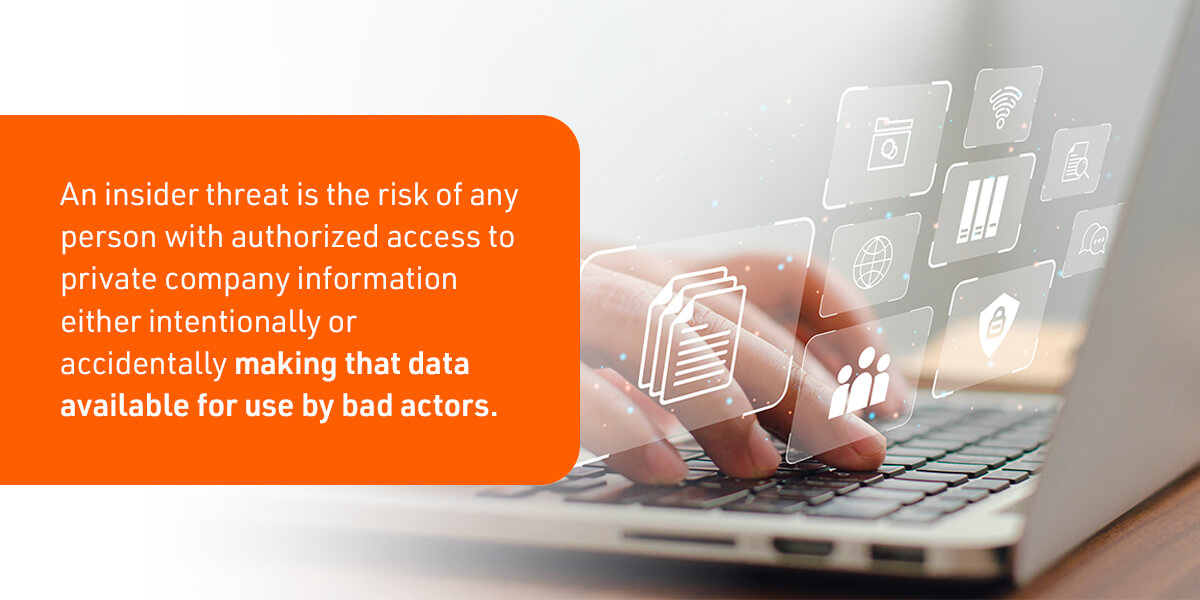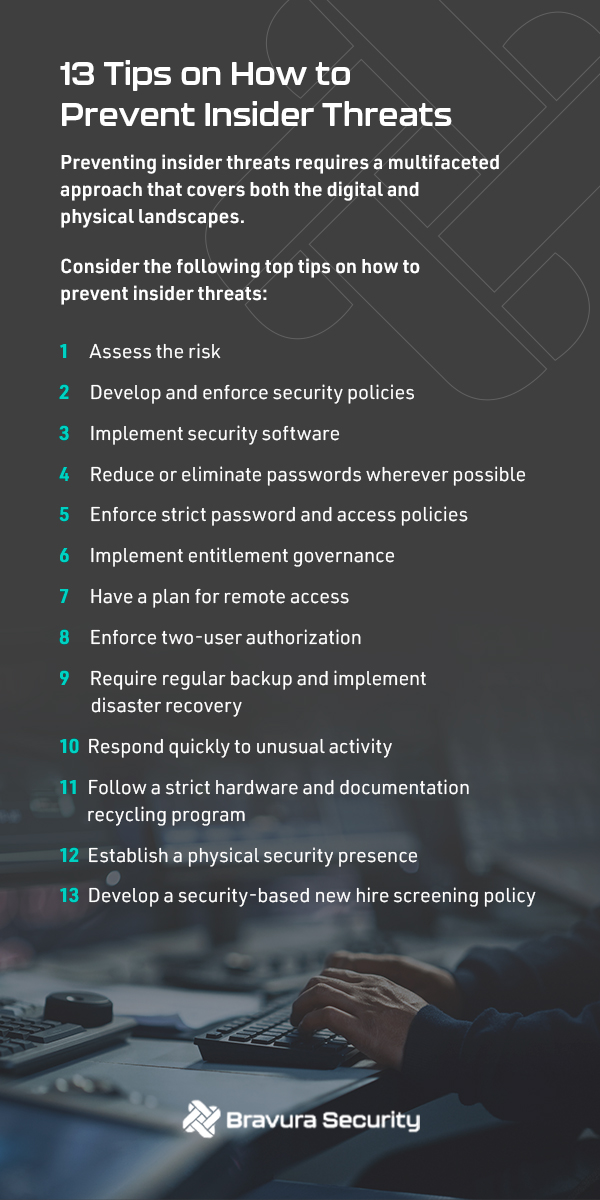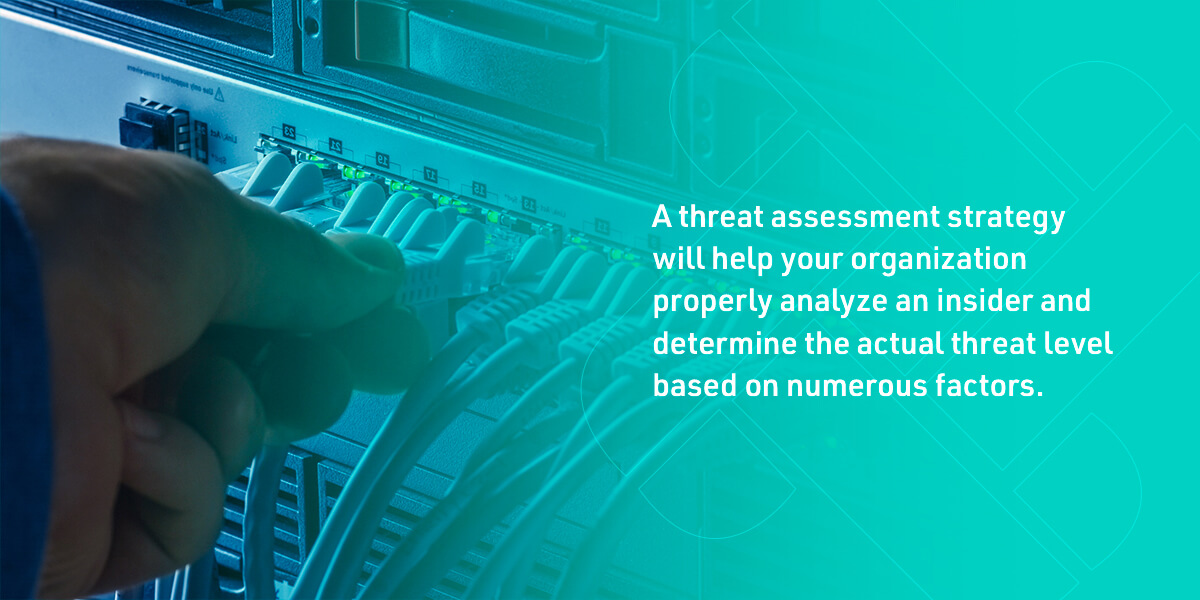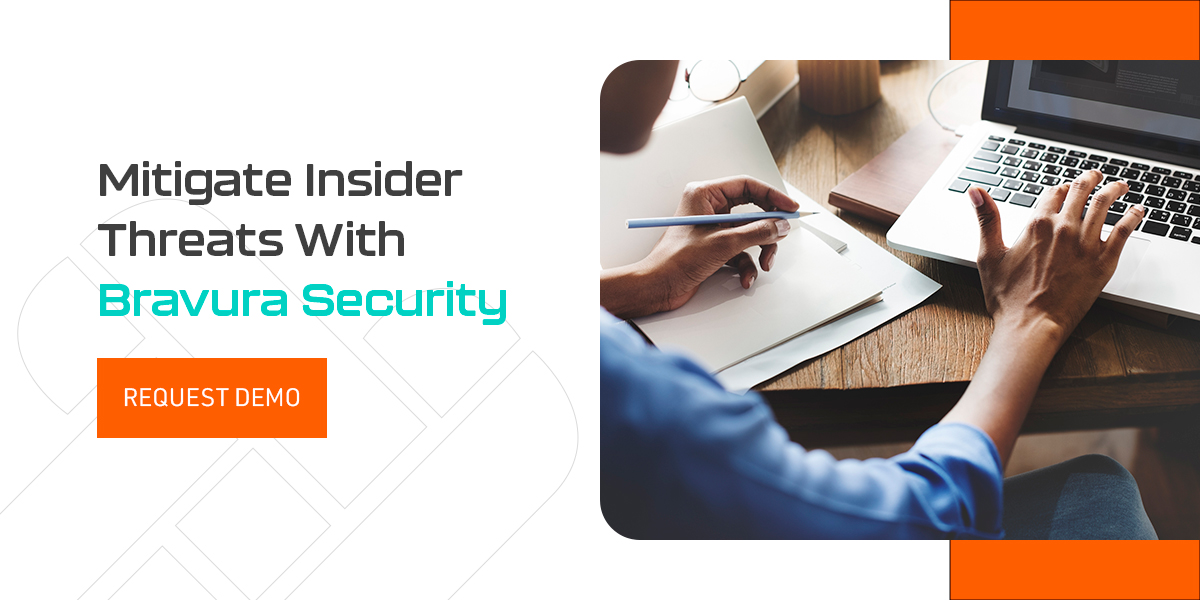Organizations have countless challenges to work through in a fast-paced dynamic consumer economy. One increasingly growing risk many business leaders are learning to contend with is the rise of insider threats to data and information security. This issue has become even more crucial due to the massive shift toward remote work.
Our guide to insider threats will help you increase your awareness of what insider threats are, how they occur and the costs associated with them. Discover proven insider threat best practices that can help you mitigate your risk of critical data loss or security breaches.
The Rise of Insider Threats
Insider threats are now a commonplace concern, as cybercriminals have begun directly soliciting the help of employees to execute ransomware attacks on their employers.
According to Bravura Security survey research, 50% of business respondents have had their employees approached to help with ransomware attacks. Further, 65% of business executives reported they or their employees were approached directly to assist in ransomware attacks.
As cybercriminals develop increasingly more sophisticated and brazen techniques, it's crucial that all organizations be aware of the risk of insider threats. Organizations must adopt effective preventive solutions, including taking particular precautions within a remote workforce.

What Is an Insider Threat?
In an organization, an insider is defined as any person who currently has or has had access to its private and confidential information, such as:
- Intellectual property, designs and patents
- Internal systems and processes
- Financial information
- Personnel data
- Customer and supplier lists
- Equipment and networks
Because insiders have authorized access to valuable information, their position within the organization makes them a potential threat to security. An insider threat is the risk of any person with authorized access to private company information either intentionally or accidentally making that data available for use by bad actors.
Depending on the nature of the insider threat, the person or group may have numerous goals in obtaining or releasing the organization's information, including:
- Sabotage: Some insiders may have malicious intent, such as the desire to deliberately sabotage an organization or carry out reprisals for some unresolved issue.
- Fraud: When insiders have access to personnel data, they could use it to commit various types of financial fraud.
- Intellectual property (IP) theft: Insiders may steal IP, including designs, lists or concepts, and resell them to competitors or use them in their new positions.
- Espionage: Sometimes, insiders work on behalf of competing organizations or agencies to steal information these other entities want.
When insiders cooperate with groups that plan and orchestrate cyber security attacks, it makes it more difficult for organizations to predict how an attack will unfold and what to do to prevent it.
Types of Insider Threats
Part of developing insider threat awareness is knowing the top sources of insider threats to security. Insider threats can come from various personnel, depending on the reasons for and goals of the attacks or breaches.
The main types of insider threats include:
- Negligent workers: Never attribute to malice what can easily be explained by incompetence, which is the case with insider threats from negligent workers. Neglect, incompetence, carelessness or a combination of all three can create a significant insider threat to organizations when employees demonstrate a dereliction of duty. Unintentional security breaches may occur when workers lose devices or have them stolen or accidentally send sensitive information to external sources.
- Departing employees: Insider threats from departing employees occur when the person either accidentally or intentionally takes unauthorized information with them, either on their phone or laptop. This may include login credentials, customer and supplier contract information or general sources of information about the organization's operating practices.
- Malicious insiders: While less common than threats from negligent or departing employees, the risk of malicious employees leaking data or information or outright sabotaging the company is still a concern. Malicious employees may be disgruntled or have an unresolved grievance that motivates them to exploit a known weakness within the organization's security systems.
- Inside agents: Insider threats from internal agents occur when someone working inside the organization cooperates with an outside malicious entity to carry out a security breach, such as a ransomware attack. Inside agents may be unaware of their coordination with the malicious outsider, which can occur when the person is tricked through social engineering tactics to give up information. Alternatively, the agent may be coerced, bribed or blackmailed into working with the malicious group.
- Security evaders: Many people view security protocols as time-consuming, inconvenient or a hindrance to productivity, leading them to find workarounds to security requirements. When employees save information on their private cloud servers or phones, these security evaders can put the organization at serious risk of an insider threat.
- Third-party vendors: An insider threat may come not from an employee or director of the organization but from a supplier. Third-party vendors often have access to valuable information or data and may not follow the necessary protocols to keep it safe, making them potential threats.
The Cost of Insider Threats
Insider threats pose a serious risk to organizations in terms of both financial and non-financial costs. Depending on the type of threat carried out, organizations can see significant losses due to security breaches or undergo a series of losses that amount to larger ones over time.
Some of the costs organizations incur as a result of insider threats include:
- Critical data loss: A cyberattack from an insider threat can result in the removal, copying, transfer or extraction of private data from servers and other digital sources. Malicious entities may alter existing data or otherwise tamper with it in some way that renders it unusable. They may also delete or destroy certain assets entirely.
- Security breach: Various security breaches can occur as a result of insider threats. Attackers may use insiders to gain access to private, confidential and sensitive information, such as names, addresses, dates of birth, social security numbers and other individual identities. For healthcare or financial institutions, breaches in security are particularly threatening because of the liability implications of failure to properly secure private data.
- Operational disruptions: Cyberattacks are incredibly disruptive and costly to organizations. IT systems teams must identify and diagnose the threat, ensure it's been eliminated and upgrade entire systems to ensure the threat doesn't occur again. This entire process can cost up to hundreds of thousands of dollars and losses in productivity and other strategic business opportunities.
- Reputation damage: When organizations suffer high-profile or significantly damaging security breaches, their reputation is at risk. Depending on the severity of the threat, an organization may lose credibility among its stakeholders, including customers, industry partners, suppliers, employees and the general public. It's harder to put a number on reputational damage, as the losses can be felt for years following the event.

13 Tips on How to Prevent Insider Threats
Given the serious risks and potential costs associated with insider threats, it's critical that organizations develop policies and strategies to prevent insider threats on an ongoing basis. Preventing insider threats requires a multifaceted approach that covers both the digital and physical landscapes.
Consider the following top tips on how to prevent insider threats:
- Assess the risk: Risk assessments of critical assets inform organizations about the potential and realistic threats their data and information face. A comprehensive risk assessment should include both outside and inside threats.
- Develop and enforce security policies: Have a security team develop and implement wide-sweeping security policies that include documented protocols. Security policies should cover all activity from general data usage to third-party access to incident response protocols.
- Implement security software: Your organization's investment in robust security software can mitigate the aforementioned costs of insider threats. Intrusion prevention, web traffic monitoring, spam filtering and data loss prevention are only a few of the services your security software should cover. With products like Bravura Safe and Bravura Pass, companies can securely manage their passwords, credentials and files and benefit from strong authentication. Another solution is Bravura Privilege, which provides password vaulting and single sign-on with privilege credentials to keep unauthorized users out.
- Reduce or eliminate passwords wherever possible: Reducing password use is an excellent strategy for decreasing the risk of insider threats. Companies can use Bravura OneAuth to eliminate passwords by using one-touch biometrics to lower the risk that credentials can be compromised. You may not be able to eliminate all passwords, like if you use a legacy system, but reducing your company's reliance on passwords is an essential step in protecting its critical information.
- Enforce strict password and access policies: Passwords aren't going away anytime soon. Every employee or vendor who has access to your organization's systems should be given individual credentials that can identify the user uniquely. Ensure all users follow account and password management best practices to prevent compromising user credentials. When organizations embrace strong password and complexity rules, users are forced to create passwords that are difficult to memorize. While good for the organization, it presents a challenge for the user. That is why it is important to adopt tools like Bravura Pass and Bravura Safe.
- Implement entitlement governance: Entitlement management is the IT security strategy that uses software to revoke or administer access to certain entitlements or user privileges to specific types of information. It's a method of controlling which users access which assets and when. Identity and Access Management (IAM) software automates entitlement lifecycle in response to business events to make this process easier.
- Have a plan for remote access: With more employees working from home than ever before, it's vital that organizations deploy sufficient protocols to monitor and control remote access. Review which employees have remote access and which devices they're using, including mobile devices.
- Enforce two-user authorization: When users need to access critical data or assets of a certain sensitivity, enforce a policy where two individual users need to authorize the activity. This is often referred to as the four-eyes principle. These kinds of assets are prime targets for would-be attackers and cannot be left unguarded. Requiring certain user roles to be involved in the authorization process further minimizes the risk of insider threats.
- Require regular backup and implement disaster recovery: Ensure mailboxes and cloud storage are regularly archived. Implement a backup system that requires an automatic backup of files monthly. Consider also developing a disaster recovery plan in the case of accidental or intentional deletion of critical data.
- Respond quickly to unusual activity: Implement ongoing monitoring of security systems and develop protocols for reporting suspicious behavior. Ensure those responsible for monitoring systems are trained on how to respond to incidents quickly. Enable alerts on all systems to receive real-time warnings of unusual user behavior.
- Follow a strict hardware and documentation recycling program: Have an internal protocol on how to properly discard old hardware, including disc drives and phones. Ensure information is wiped completely and non-recoverable. Physically destroy any hardware that contains critical information and assign a specific IT personnel member to oversee this process. The National Institute of Standards and Technology provides guidelines on proper media sanitization to help companies protect their information.
- Establish a physical security presence: Consider that not all threats originate digitally. High-traffic buildings require a professional physical security presence to mitigate the risk of unauthorized intruders. Security personnel can identify suspicious people and prevent them from entering certain areas with critical infrastructure, such as server rooms. Include other security protocols like requiring all visitors to disable their smartphone cameras and ensuring all visitors to server rooms lock the doors after use. Install surveillance systems, including cameras and motion sensors. Server rooms and other infrastructure housings are often guarded by Physical Access Control Systems (PACS). Often, these systems are modern enough that they can be integrated with an Identity Access Management system such as Bravura Identity.
- Develop a security-based new hire screening policy: Organizations in the financial, tech and healthcare sectors are at significant risk of insider threats due to the valuable nature of the industry's assets, data and processes. Develop a thorough security screening protocol for new hires that's integrated into the hiring process. This can be one of the most cost-effective methods of preventing insider threats.
Insider Threat Mitigation Strategies
Beyond basic insider threat best practices and security protocols, organizations need a robust insider threat mitigation strategy at the core of their security plans. Protecting critical assets requires an approach that includes technology solutions that can define specific insider threats, know how to look for them, assess the best approach to dealing with them and execute a plan to control the threat.
For the best approach to handling security threats from the inside, try the following four-step approach to insider threat mitigation:
1. Define the Threat
The first step in mitigating insider risks is to have a full understanding of what constitutes an insider threat, how they occur and the types of people typically involved. Cybercriminals look for a point of entry into your organization's data, whether through phishing campaigns, social engineering or some other way of obtaining permissions through an insider threat. Once the cybercriminal has access, they gather more data about your organization, looking for additional systems and accounts they can exploit. This process is called moving laterally.
2. Detect and Identify the Threat
Mitigating insider threats means having a way to prevent threats before they arise. Bad actors might look for orphaned and dormant accounts, which a former employee once held but the organization hasn't closed since their departure. Our Bravura Identity solution ensures new employees only have access to the accounts they need, and those accounts don't remain in your organization's system when an employee leaves or transfers.
Additionally, it's essential to manage strong passwords for highly privileged systems and limit the number of employees who know them. Bravura Security specializes in password protection to remove the weak link of negligent, departing or malicious employees. Bravura Privilege accomplishes this by rotating passwords for each new user and recording when and how users use these credentials to gain access to systems.

3. Assess the Threat Level
Deploying security resources is costly and time-consuming, so it's important to appropriately respond to potential threats based on their threat levels. Our insightful reporting provided by the Bravura Security Fabric platform and framework helps to uncover vulnerabilities in accounts, entitlements, groups and metadata. In fact, many of the reports can be used to drive workflow and initiate remediation.
4. Manage the Threat
Managing insider threats is about being proactive and neutralizing threats before they materialize. Various interventions can help organizations manage insider threats. At Bravura Security, we generate strong passwords for our users and store them in an enterprise safe they can access through a web browser or mobile app. This strategy removes the need for users to know their passwords, making it harder for cybercriminals to social engineer information from them.
Our Bravura OneAuth solution is a passwordless authentication software that uses multi-factor authentication to mitigate threats. Even if a cybercriminal accesses your organization's passwords, using Bravura OneAuth means they won't have the information they need to get into your systems.
Mitigate Insider Threats With Bravura Security
With the right security strategies and technology, organizations can be better prepared to defend themselves against the rise of insider threats. Take a proactive approach to mitigate insider threats with Bravura Security. Discover the benefits of Bravura Security for your organization and learn more about how our products can support you in detecting and mitigating insider threats and potentially malicious behavior.
Request a demo today to have our identity and access management experts give you a guided tour of our products.
Related Articles
Combat Password Spraying & Brute Force Attacks
Cybersecurity threats are evolving, and higher education institutions are not immune. With many user accounts, universities and colleges present attractive...
